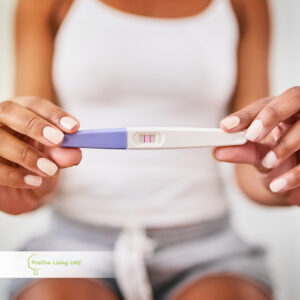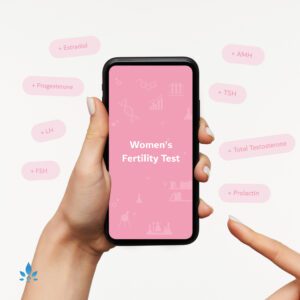Getting Started with Nabta Health: Your 101 Guide to Fertility


Deciding you want to become pregnant and have a baby can be an incredibly exciting and overwhelming time. Fertility can be affected by many factors and there are ways to increase your chances of conceiving naturally. However, for some trying for a baby may not go as hoped or planned, and they might need further medical assistance to conceive.
Wherever you are on your fertility journey, Nabta Health will support you with resources, knowledge, and access to experts.
How can I increase my chances of getting pregnant naturally?
First things first. There are lifestyle steps you can take in the months before you start trying for a baby to prepare your body for conception.
- Take prenatal vitamins: To ensure your body is nutritionally strong, with all the minerals and vitamins you need for strong fetal development, start taking prenatal vitamins with folic acid at least three months before you try to conceive.
- Follow a balanced diet: Boost your health with a varied diet covering all food groups. Avoid refined sugars, saturated fats and too much salt.
- Maintain a healthy weight: Being underweight or overweight can impact fertility.
- Exercise regularly: Exercise that builds strength, endurance and muscle tone will help your body stay healthy and strong during pregnancy and labour.
- Get lots of rest and sleep: Sleep patterns can affect hormones. Stick to a regular 7-8 hours sleep routine as you prepare your body to conceive.
- Reduce stress: High stress levels are linked with difficulties getting pregnant. Give yourself a break when you can and take the pressure off. If you’re feeling frazzled, try taking up yoga and practice mindfulness.
- Stop smoking and quit drugs. Limit alcohol intake and cut back on caffeine.
- Come off contraception: If you’re on hormonal contraception (the pill, IUD, patch, ring implant) it can take some months for your body to readjust and your cycles to return to your personal ‘normal’. Of course, this doesn’t apply if you use condoms or a diaphragm for contraception as they simply act as a barrier to conceiving.
- Get a well-woman health check: Consider getting a full medical, including a check-up for any sexually transmitted infections (STIs). While this is by no means essential, your healthcare team will help you manage any potential red flags, family medical history or underlying health conditions that could af you getting pregnant naturally or having a healthy pregnancy.
How do women become pregnant?
The traditional way for heterosexual couples to get pregnant is through unprotected sexual intercourse.
Pregnancy is a question of timing (among other individual factors). Heterosexual couples who want to get pregnant will need to time sex with ovulation. The man’s sperm must meet and fertilise the egg at the right time. Knowing her fertile window and timing intercourse with ovulation is one of the most important factors in increasing a woman’s chances of conceiving.
What is ovulation?
The ovaries release the egg once every cycle, during ovulation. That egg travels down the fallopian tubes and waits to be fertilised by a sperm. The egg can wait for 12-24 hours for a sperm to successfully push through its outer surface. Sperm can live inside the female reproductive tract for 3-5 days waiting to fertilise an egg. All being good the fertilised egg makes its way to the uterus (womb) and implants in the uterine lining.
How do I know when I’m ovulating?
Women typically ovulate around 12 to 14 days before their next period. If you have regular periods (the average menstrual cycle is 28 days but it’s normal for women’s cycles to be anywhere from 21 to 40 days) you can count back from the first day of when you would expect your next period.
Fertility experts recommend having sex at least every other day in the lead-up to ovulation. Sperm can survive for several days in the female reproductive tract but once you’ve ovulated your egg has a 12-24 window for fertilisation so for the best chances of conception have enough sex in the time leading up to that brief window.
What is fertility awareness and natural family planning?
Fertility awareness methods (FAMs), also known as natural family planning, is used by women both as a method of contraception and to predict when they are most likely to conceive.
Women can monitor several physiological cues alongside tracking menstrual cycle length to determine when they are most fertile:
- Checking cervical mucous: Understanding how your cervical mucous changes during your cycle. As you near ovulation you’ll notice your discharge becomes clear, stretchy, and wet, with the consistency of raw egg whites. This is known as fertile quality mucous and you are now at your most fertile.
- Charting your basal body temperature (BBT): There is a small rise in body temperature after ovulation. Measuring your BBT can help you predict the exact point of ovulation. Women with regular periods can measure BBT for 3-4 cycles to gain a fairly accurate prediction of when they are most fertile
- Monitoring cervical mucous and BBT are non-invasive, easily accessible methods to track fertility. Using these two approaches together is known as the symptothermal method.
Other methods for tracking ovulation include:
- Calendar method: This works by recording menstrual cycles on a calendar for 6-12 months and calculating fertile periods. It is most effective as a fertility predictor when combined with cervical mucous and BBT methods.
- Ovulation predictor kits: Over the counter ovulation kits work in a similar way to at-home pregnancy tests. The woman pees on a stick measuring luteinizing hormone and a surge in this hormone indicates ovulation. However, it doesn’t prove an egg has been released and a woman can have the hormone surge but fail to ovulate.
- Period tracker apps: Smartphone ovulation tracker apps, like OvuSense, monitor menstrual cycles and predict fertility. If you do choose to use a smartphone tracker app, be sure to read the small print for data collection policies.
Fertility awareness, knowing and understanding your body and its menstrual cycles, helps lots of couples to conceive. However, getting pregnant isn’t always as simple as knowing your body and having lots of ‘baby making sex’. Some women want children but either cannot conceive naturally or keep miscarrying.
And obviously, there are different considerations for women who have irregular periods due to endometriosis or PCOS, those whose fertility is affected by illness or genetic history, and people who are single, transgender, or in same-sex relationships.
What affects female fertility?
Egg numbers and quality start to decline after 35, increasing the risk of age-related infertility. The risk of pregnancy-related complications also increases with age. Underlying health issues, endometriosis, uterine polyps or fibroids, polycystic ovarian syndrome (PCOS), problems with the fallopian tubes, and ovulatory problems can all affect fertility.
What affects male fertility?
Male fertility problems can be caused by low sperm count, poor quality sperm, or blockages preventing sperm moving through the reproductive tract. Sperm can be vulnerable to lifestyle and environmental factors including raised body temperature, weight gain, exposure to toxins, smoking, heavy alcohol intake and drug use.
What if I can’t get pregnant naturally?
Doctors define infertility as the inability to conceive after one year or longer of regular unprotected sex.
If you are a woman in a heterosexual relationship and struggling to conceive using fertility awareness and natural family planning methods, both you and your partner should seek a medical and physical evaluation.
In some situations, if a woman is 35 years or older, doctors may decide to investigate and treat infertility after 6 months of unprotected intercourse.
Fertility testing for women
Testing will depend on individual health and medical history, but typically initial testing will include routine blood work to check for:
- Anti-Müllerian Hormone (AMH): Ovarian reserve test to estimate how many eggs a woman has.
- Follicle-Stimulating Hormone (FSH): Hormone stimulates the follicle producing the eggs.
- Luteinizing Hormone (LH): Responsible for follicle production and egg maturation.
- Prolactin (PRL): Hormone released from anterior pituitary gland, raised during pregnancy in preparation for breastfeeding, and in women with infrequent periods.
- Thyrotrophin (TSH): Can indicate an underactive thyroid, linked with irregular periods.
- Estradiol: A form of estrogen, the test measures ovarian function and egg quality.
- Androgen: High levels can prevent the ovaries from releasing an egg and may indicate polycystic ovarian syndrome (PCOS).
- A Vaginal ultrasound will check:
- Reproductive organ health.
- Ovaries for cysts, fibroids, polyps, PCOS, endometriosis, or any abnormalities.
- Egg reserve.
Sometimes an X-ray is also carried out:
Hysterosalpingography (HSG): Examines inside of the uterus (womb) and fallopian tubes for blockages or anything that might be stopping the sperm from reaching the egg.
Fertility testing for men
Blood work for men will check hormone levels and scan for certain infections or a possible genetic cause for infertility. A doctor may request a sperm sample to assess sperm count, shape and movement, and a scrotal ultrasound to check if there are any problems or blockages in the testicles preventing sperm getting into a man’s ejaculate.
Fertility treatment options
Each person’s fertility scenario is unique, and any recommended infertility treatment will depend on an individual’s own health and medical history.
A woman with a blocked fallopian tube or a man who isn’t producing sperm will be offered procedures to remove the blockage, repair damage or retrieve sperm, before trying other fertility treatments.
If appropriate, fertility specialists will often recommend that women start with clomid, a prescribed oral medication for infertility. This is also the preferred approach for women with hormonal conditions such as polycystic ovarian syndrome (PCOS).
Clomid works by stimulating an increase in the levels of follicle-stimulating hormones, initiating ovulation and increasing the odds of pregnancy. For some women this approach is combined with intrauterine insemination (IUI), in which the male partner’s or donor’s sperm is inserted directly into the uterus to increase the probabilities of conception.
If that approach doesn’t work, or if it’s clear from a woman’s medical history it won’t work, the next step would be treatments such as in vitro fertilisation (IVF). IVF involves retrieving eggs from a woman’s body, fertilising the eggs in a laboratory, and transferring the resulting embryo back into her body. The process is lengthy, invasive, and expensive and can take an emotional toll. However, for many women who want children it is their only option.
Fertility treatments vary depending on a woman or couple’s situation. People who are single, in same-sex relationships or transgender will have their own fertility journeys and in these cases a woman’s age and fertility status still plays a role. Fertility experts will offer the necessary support and advice for each individual scenario.
Getting started on your fertility journey with Nabta Health
Whatever your personal situation, whether you’re thinking about starting a family, having another child, or you’ve been trying for years without success, Nabta Health will support you on your fertility journey.
From health and lifestyle tips for pre-conception and PCOS, to relationship coaching, pregnancy wellness products, and at-home vitamin, thyroid, and fertility testing, Nabta’s fertility marketplace and knowledge resources are designed to accompany you through each stage from pre-conception to birth.













































